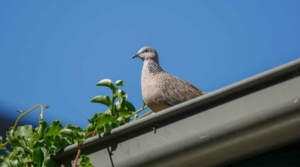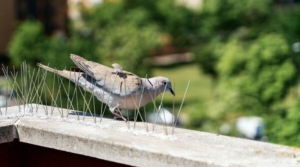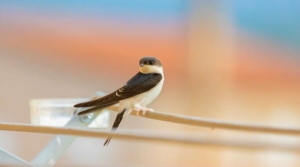Guide to Bird Control
4 Steps to Control and Prevent Bird Infestations
Dealing with pesky birds on your property can be extremely frustrating.
From pigeons to seagulls, birds seem to have a knack for setting up camp exactly where you don’t want them.
Don’t worry – with some knowledge about bird and deterrent options, you can reclaim your space and prevent birds from returning.
Step 1: Identify the Bird Species
The first step is identifying the type of birds you are dealing with. Different species respond better to different deterrents. Here are some of the most common pest birds and their traits:
- Pigeons – Bluish-gray birds that nest on surfaces and eat discarded food. They are found in urban areas.
- Seagulls – Large gray and white birds with hooked beaks often found around beaches and dumpsters.
- Crows – All black birds that are very intelligent. They cause issues by roosting on roofs and dropping debris.
- Starlings – Small black birds with pointed beaks that gather in huge flocks and leave droppings everywhere.
Take note of the birds’ size, color patterns, beaks, wings, and feet to help identify them. Listen closely to any noises they make. Consult a bird field guide or app if you need help.
Step 2: Inspect Their Entry Points, Nesting Spots, and Food Sources
Once you know what kinds of birds you are dealing with, do a thorough inspection of your property to find out how they are getting access. Check for:
- Openings in eaves, vents, chimneys, holes in walls
- Cavities on roofs, signs of materials used for roosting.
- Bird feeders, pet bowls, trash cans, compost piles
Seal up any entry points with chimney caps, hardware cloth, caulk, weather stripping, or other exclusion materials. Remove any nests and droppings safely. Eliminate outdoor sources that might attract birds.
| Bird Species | Common Entry Points | Nesting Spots | Food Sources |
|---|---|---|---|
| Pigeons | Eaves, attics, ledges | Crevices on buildings | Litter, grain spills |
| Seagulls | Rooftop ducts and vents | Flat gravel roofs | Landfills, fishing docks |
| Crows | Chimneys, holes in siding | Treetops, rain gutters | Roadkill, birdseed |
Step 3: Treat Affected Areas
For birds that have already taken up residence, you’ll need to use deterrents to make them leave. Start by safely removing any nests and droppings so new birds won’t be attracted. Then apply repellents:
- Physical deterrents – Install bird spikes, slope modifications, or netting over entry points and roosting spots.
- Audible deterrents – Use predator bird calls, ultrasonic devices, aluminum foil pan clatter deterrents.
- Visual deterrents – Get a fake owl statue, hanging flash tape, predator decoys, or reflective deterrents.
- Chemical deterrents – Apply non-toxic repellent gels or solutions on roosts.
Using a combination of 2-3 different deterrent types works best to scare birds away. Be patient, as it make take days or weeks for stubborn birds to leave for good.
Step 4: Prevent Birds From Returning
After removing all birds from your property, take proactive measures to keep new ones from invading:
- Install bird netting over ponds, gardens, patios, and other areas prone to birds to create a physical barrier.
- Attach spikes, slope modifications, or electric track systems to prevent roosting.
- Use dummy eggs and reflective deterrents to discourage roosting.
- Keep lids on trash cans and eliminate other sources.
- Use automated laser/water devices or predator decoys to scare off birds.
- Consider getting a falconer to bring in a live predator bird for a short period.
Be vigilant and keep monitoring for new birds trying to enter. Having multiple deterrents in place will reinforce that your property is an unpleasant place for birds!
Key Takeaways
- Identify the bird species and how they are accessing your property.
- Seal up entry points and remove sources and roosting spots.
- Apply audible, visual, and deterrents to scare birds away.
- Continue using deterrents and exclusion methods to keep new birds out.
FAQ’s
What are humane ways to get rid of birds?
Humane bird deterrents include plastic spikes, slope modifications, netting, ultrasonic devices, sprinklers, reflective items, predator decoys, and non-toxic repellent gels. Avoid methods that harm birds like glue traps or avicide poisons.
How do I get birds to stop nesting on my house or building?
Block access holes, install bird netting or make slope modifications over roosting spots, remove old perches, use predator decoys, and install flashing lights. Reapply deterrents before each breeding season to control the bird population.
Should I get a professional to handle bird problems?
For large infestations, high nests, or hazardous droppings, hire a pest control professional. They have equipment, deterrents and expertise to remove birds safely and legally.
What are the risks from birds nesting near my home?
Bird nests can harbor mites, ticks and fleas. Droppings may contain histoplasmosis spores. Birds can also damage insulation and wiring in walls and attics, and make noise.
Conclusion
Controlling bird infestations takes patience and persistence, but is very feasible for most homeowners to tackle themselves.
The key is identifying how birds are accessing your home, sealing up those entry points, removing sources and nests, and installing a layered defense of deterrents.
With vigilance and proactive prevention, you can successfully reclaim your space from nuisance birds!



